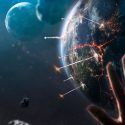It’s invisible, deadly and sucking up every bit of matter in its path. The most massive black hole in the known Universe is headed right toward Earth. What would you see as it started to slurp up the Milky Way Galaxy? What kind of tasty dish would Earth become? And once it’s finished with us, where would it go next?
Black holes aren’t that much different than any other object in the Universe that has mass. Except that they are really, really dense. At their center is a singularity, an infinitely small point, where all its matter is compressed. The more matter that is condensed into this singularity, the stronger the gravitational pull.
Most black holes are the remnants of massive stars and generally range between 10 to 100 solar masses. And one solar mass is the equivalent of 333,000 Earths. That’s a lot of gravity. But supermassive black holes, which lurk at the centers of many galaxies, could contain millions or billions of solar masses. And scientists think there are black holes as large as 100 billion solar masses, aka stupendously large black holes, or SLABs.
Catch one of these moving toward our Solar System and get ready to wave bye-bye to all your conceptions of space and time. The largest known black hole, TON 618, has begun its long trek directly toward our Solar System with its 66 billion solar masses in tow. And long trek is no overstatement. It would be traveling at least 10 billion light-years to reach us.
As it steamrolled through space, it would gobble every bit of dust and gas in its path. It would also snack on many stars before it even reaches the Milky Way. Depending on its route, this could mean hundreds of billions of stars added to its size. Before making first contact with our galaxy, it would have pulled in enough matter to disrupt its neatly organized spiral.
You’d be able to detect its initial approach toward us as you observe the increasingly intense radiation it emits. Eventually, it would come bearing down on the last of the Milky Way’s spiral arms, the Orion Arm. TON 618 would gobble up its entire 20,000 light-year length. It would be like an unbelievably long buffet line straight to the center of our galaxy.
Somewhere along this line, it would finally knock at our front door. The Oort Cloud is a spherical shell of icy debris that surrounds the Solar System. Or at least it was that before TON 618 showed up. It would then continue on its way and consume the Kuiper Belt, just beyond the orbit of Neptune. The danger to Earth would steadily increase as hundreds of thousands of icy bodies would be sent hurtling this way.
As TON 618 kept pushing forward, it would devour the ice giants, Neptune and Uranus. And the gas giants, Saturn and Jupiter, would be pulled apart atom by atom. Not only the planets, but their moons and every asteroid that the giant black hole comes across.
Any future plans to settle on Mars would be squashed as the red planet would end up right smack in the middle of this black hole too. And now, there would be nothing left in the way of TON 618 and Earth. While the center of this stupendously large black hole would be almost 295 billion km (180 billion mi) away, we’d finally be right up against its event horizon.
That’s the boundary marking a black hole’s point of no return. The pull of its gravity would now be totally inescapable. Our whole planet would stretch out while simultaneously getting more and more compressed. Eventually, Earth would become a lot like a strand of spaghetti slurped into an empty black void.
Then, this black hole monstrosity would gobble up the Sun in one big gulp. Now at the center of what once was our Solar System, TON 618 would occupy nearly as much space. It would extend almost all the way to the inner edges of what used to be the Oort Cloud.
And since it’s not polite to leave any food on your plate, TON 618 would continue on its path toward the black hole at the center of the Milky Way, Sagittarius A*. As these two massive black holes collide, it would be so powerful that it could cause ripples in the very fabric of space-time. But what happened to you as you got pulled into a black hole?
Sources
- “How Far Away Is Mars? | Distance To Mars”. Daisy Dobrijevic. 2022. space.com.
- “NASA – Solar System Scale “. 2022. nasa.gov.
- “What Happens At The Center Of A Black Hole?”. Paul Sutter. 2022. space.com.
- “What Exactly Is A Black Hole Event Horizon (And What Happens There)?”. Charles Q. Choi. 2019. space.com.
- “‘Stupendously Large’ Black Holes Could Grow To Truly Monstrous Sizes”. Charles Q. Choi. 2020. space.com.



























